
|
Sale 72
February 2-5. 2013
| Lot |
Photo |
Description |
Realized |
Lot 1734 |
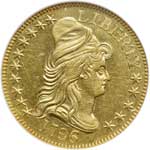 |
1796, 6 over 5. Small eagle. NGC graded MS-61. Well struck and untoned. Brilliant semi reflective fields throughout. Only 6196 struck. This outstanding Mint State 1796 overdate Half Eagle shows a bold strike on a well prepared planchet with untoned reflective surfaces. We note some very minor planchet roughness on the reverse between ER and the denticles. This is mentioned for identification purposes since it does not detract from the coin's beauty and overall appearance. With fewer than 6200 in the often incomplete Mint records, further study done by Bass-Dannreuther estimates only 1,057-2,000 were actually struck.
The desirable first overdated half eagle issue with a Small Eagle reverse. Sharply struck excluding on the eagle's neck and body where the traditional soft image occurs; Liberty's hair and the cap are exceptionally well defined on this often poorly struck example. The nice golden surfaces are very presentable and merit your consideration because they are so free from the usual friction from circulation; there is even a trace of semi-reflective quality. Very high quality for this desirable, early gold type. Rarely offered in Mint condition
The reverse die which struck 1796/5 BD-1 was earlier used in 1795 for BD-12, and the wreath appears to have been shallowly punched into the die, attenuated leaves resulting from even a light lapping. It appears the dies clashed and were reground at some point after its 1795 use. According to Dannreuther, concerning the mintage: "although the mintage figures reported for the year 1796 undoubtedly contained coins dated 1795, there may be as many as 100 extant for this year. Many auction sales are repeat appearances, as the popularity of this single date/variety makes it a frequent trader." A marvelous opportunity for the rare gold specialist! Pop 2; 12 finer.
History: The Half Eagle has the distinction of being the first gold coin struck in the United States Mint. Production begin in 1795, and it remained fairly steady through the denomination's end in 1929. For much of its life, the Half Eagle was the most popular gold coin with banks and other bullion depositors, and it was definitely favored over the Quarter Eagle and Eagle during the early decades of Philadelphia Mint operations. Popularity has its price, however, and for the Half Eagle that price was extensive circulation. This truly was a workhorse denomination, even in the 1790s and early 19th century, and even some later issues with generous original mintages are scarce-to-rare either in an absolute sense or in Mint Condition. In fact, the Half Eagle series includes types that are among the rarest and/or most conditionally challenging in the entire U.S. gold family. The earliest Capped Bust, Small Eagle pieces are particularly hard to find in choice condition. All issues in this series suffered extensive exportation and melting due to rising gold prices on the world market.
Upon his appointment as director of the U.S. Mint in 1795, Henry William DeSaussure set two goals for himself: place gold into circulation and improve the design of all circulating coins. He achieved his first goal on July 31 of that year with the transfer of 744 Half Eagles from the chief coiner to the treasurer of the Mint. These coins bore Robert Scot's Capped Bust Right, Small Eagle design that would remain in production through early 1798. While examples were struck bearing every date from 1795 through 1798, production was interrupted on more than one occasion when the Mint closed for the yearly yellow fever epidemic that plagued Philadelphia during the late 18th and early 19th centuries. The 1795 is probably the most popular issue of this type due to its historically significant, first-year status, and collectors consider the 1798 Small Eagle to be by far the rarest. The overdate 1796/5 has a special place in our hearts as the earliest overdate in this illustrious $5 series.
Estimated Value $100,000 - 115,000.
View details and enlarged photos
| Unsold |
Lot 1735 |
 |
1799. Small star reverse. . BD-1, Breen-6433. PCGS graded MS-62. Lovely golden toning with semi reflective surfaces. On this variety, the 1 of the date is near the curl. On the reverse, the small stars are in a Cross Pattern. Danreuther estimates 1,500 to 2,500 pieces were struck from this die, but assigns a Rarity-5+ rating with a suggestion that only 35 to 45 are known!
Velvety to satin-like fields almost stagger under the weight of its highly lustrous golden color with minimal marks or hairlines and natural light frostiness. Struck with controlled precision throughout the outer peripheral areas, although somewhat weak and compromised (from worn dies?) at the following locations: eagle�s head and chest, the ribbon, and top (horizontal) shield lines. Liberty�s hair is mainly complete barring a flat area to the left of her ear as often seen on this Type. Choice rims free from marks; spot-free with a tiny coppery stain near the C of AMERICA which can be used for provenance tracing. Pop 11; 9 in 63, 1 in 64. (PCGS # 8081) .
Under the terms of the Coinage Act of 1792, the obverses of all the coins, copper, silver, and gold, had to depict Liberty, then as now an allegorical female figure. The reverses of the silver and gold coins had to depict an eagle. With those requirements in force, and a requirement that certain inscriptions appear on all the coins, mint engraver Robert Scot set to work in 1795 on the eagle designs.
The gold half eagle obverse depicts a bust of Liberty facing right and wearing a soft cap (not the pileus or Liberty cap found on the Liberty cap half cent and cent, among other U.S. coins). Liberty�s hair flows freely, down over her truncated shoulders.
LIBERTY occupies the under border above and to the right of the portrait, with stars arranged along the back of her head and from the Y in LIBERTY to the tip of the bust. The number of stars and their arrangement and exact positioning of LIBERTY vary from year to year.
Production was low in 1795-98. Production continued even lower when 7,451 coins for 1799 were issued, giving this issue of capped bust half eagle a strong edge over the more common 1802-07 period pieces.
Estimated Value $35,000 - 38,000.
View details and enlarged photos
Check results on similar lots
| Unsold |
Lot 1736 |
 |
1807. Capped Bust Left. . BD-8, Breen-6453. NGC graded MS-62. Well struck and mostly untoned. Only 51,605 minted. A smooth and virtually mark-free select coin with a gradation of luster across the fields and devices on both sides. The contact from the dies is virtually complete, although perhaps a hint of weakness is seen at the upper edge of the rim above TE(S) on the reverse, involving those letters as well. This is due to minor adjustment along the upper reverse rim. In 1807, the switch was made from the Capped Bust Right, Heraldic Eagle design to this newer, fresher one by John Reich which has Liberty facing left and a simplified eagle. Reich�s secret "signature" is visible in the final star on the right where there is a small notch in one of the star points. A handsome Mint State example for the collector of early U.S. gold. Struck at the time Thomas Jefferson was President of the United States and the famous Fulton Steamboat began to ply its trade. Pop 43; 43 finer (PCGS # 8092) .
Estimated Value $12,000 - 13,000.
View details and enlarged photos
Check results on similar lots
| Realized
$13,800 |
Lot 1737 |
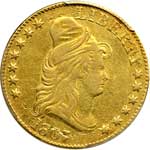 |
1807. Bust Right PCGS graded Genuine XF Details. Surface damage. Last year of this design. Almost six months to the day after John Reich became Assistant Engraver of the Mint, assigned to produce improved designs on all denominations, his new half eagles appeared; Mint Director J. R. Snowden said the date was Sept. 30. 1807 (PCGS # 8092) .
Estimated Value $1,500 - 1,700.
View details and enlarged photos
Check results on similar lots
| Realized
$3,450 |
Lot 1738 |
 |
1810. Large Date, Large 5 PCGS graded Genuine AU Details. . BD-4, Breen-6459. Scratch. Lightly toned. Minor adjustment lines at upper left obverse rim. Still lustrous around the stars and legends as well as within the devices. A well struck coin for the period. A "Type" date and variety, the 1810 Large Date, Large 5 half eagle is one of the more plentiful in the 1807-12 Capped Draped Bust series (PCGS # 8108) .
Estimated Value $1,500 - 1,600.
View details and enlarged photos
Check results on similar lots
| Realized
$4,025 |
Lot 1739 |
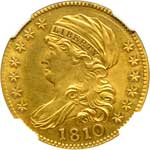 |
1810. Large Date, Large 5 NGC graded AU Details. . BD-4, Breen-6459. Repaired, showing some minor tooling. Well struck on hair curls, stars, and the majority of the eagle's plumage. Early US gold like this has been collected avidly since the middle decades of the 1800s (PCGS # 8108) .
The Year 1800: For much of January and February, tributes to George Washington were held in cities and towns in the various states. Washington had passed away on Dec. 14, 1799. Mason Locke Weems, an Episcopal clergyman, published The Life and Memorable Actions of George Washington, which went into multiple editions, the fifth of which (published in 1806) included the fanciful tale of young Washington and the cherry tree. Much of Weems' fiction passed into popular "history." Hymns and Odes Composed on the Death of General George Washington, was published and included contributions from many sources, including Thomas Paine.
In the presidential election of 1800, Democratic-Republican Thomas Jefferson won 73 Electoral College votes as did Aaron Burr, followed by 65 for President John Adams and 64 for Charles Pinckney. After many more ballots, the opposition of Alexander Hamilton to Burr swung the majority to Jefferson's side in February 1801.
Estimated Value $1,500 - 1,600.
View details and enlarged photos
Check results on similar lots
| Realized
$3,795 |
Lot 1740 |
 |
1813 Capped Head Left. . BD-1, S of STATES centered over E. SEGS graded MS-61. Light hairlines in the obverse fields. With more than 50 percent more coins struck for this type than for the previous type, one would think that the dates and varieties of 1813-28 would be seen more often than those of the previous type (1807-12). Because there were relatively few gold coins in circulation stateside from 1812 onward, and none were seen after 1821 until the introduction of the lighter gold coins after July 31, 1834, this turns out to be a scarce Type. Many were exported for use elsewhere, or melted and turned into local coins. Some estimates suggest that only 2% or 3% of the original mintage survives. Mint State quality specimens are scarcer still. A well struck, attractive example.
Estimated Value $7,500 - 8,000.
View details and enlarged photos
| Realized
$10,638 |
Lot 1741 |
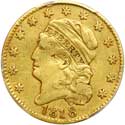 |
1818 PCGS graded Genuine VF Details. Surface damage. Only 48,588 minted of which merely 67 examples are estimated to have survived. The center is slightly bent. Utilizing Obverse 2, Reverse B, this is a famous variety, recognized for a widely spaced STATES OF appearing as one word (PCGS # 8119) .
Estimated Value $1,800 - 1,900.
View details and enlarged photos
Check results on similar lots
| Realized
$2,875 |
Lot 1742 |
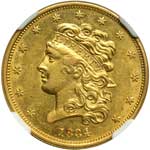 |
1834. Plain 4. NGC graded AU-58. Lightly toned. Lustrous. A desirable example of the modified weight & design series of 1834-38 whose designer, William Kneass suffered a debilitating stroke in 1835. Dies made after this time were by his able assistant, Christian Gobrecht (PCGS # 8171) .
Estimated Value $1,700 - 1,800.
View details and enlarged photos
Check results on similar lots
| Realized
$2,070 |
Lot 1743 |
 |
1834. Plain 4 PCGS graded Genuine AU Details. Cleaning. Nice semi-reflective surfaces. Changes to the gold-silver alloy in 1834 necessitated a new design for the $2.50 and $5 gold pieces (the only ones then being produced). Designs by William Kneass (PCGS # 8171) .
Estimated Value $500 - 550.
View details and enlarged photos
Check results on similar lots
| Realized
$661 |
Lot 1744 |
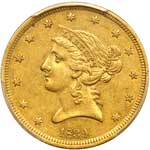 |
1839. PCGS graded AU-50. Nice gold toning. Pop 20; 44 finer (PCGS # 8191) .
Estimated Value $750 - 800.
View details and enlarged photos
Check results on similar lots
| Realized
$1,265 |
Lot 1745 |
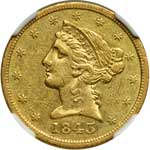 |
1843-D. NGC graded EF-45. Untoned and well struck with some light surface abrasions from its years in circulation. The gold half eagle was the workhorse denomination in this metal throughout much of the 19th century, just as the half dollar was the main circulating silver coin used in more modest day-to-day transactions. Smaller gold and larger gold was not used as much, mainly as bank backing of paper money issues and for import-export purposes along with non-circulating gold bars.
Estimated Value $1,800 - 1,900.
View details and enlarged photos
| Realized
$2,185 |
Lot 1746 |
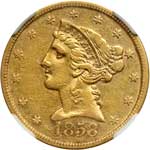 |
1858-S. NGC graded AU-50. Only 18,000 minted. The 1858-S Half Eagle marks the launch of a run of scarce S-mint Half Eagles that spans almost two decades. The few remainders from the original release generally grade Extremely Fine at best. This reddish-gold, lightly abraded example is well struck in all chief areas and displays only minor marks from its time in circulation. Pop 8; 25 finer (PCGS # 8279) .
Estimated Value $3,600 - 3,800.
View details and enlarged photos
Check results on similar lots
| Realized
$3,795 |
Lot 1747 |
 |
1862-S NGC graded XF Details. Improperly cleaned. Low mintage. Despite the activities of hoarders in the East and extensive use of gold in paying for imports, gold coins continued to circulate out West throughout the Civil War (1861-65) and later, until gold returned to "par" against greenback paper money at the beginning of 1879. It can only be assumed that most of the 9,500 half eagles coined in San Francisco in 1862 reached circulation, being lost, later melted, or heavily worn. Most survivors grade Extremely Fine, though lower examples with an average grade of just Very Fine 20 were recorded in 1979 by David Akers who considered this issue to be among the scarcest issues of the series (PCGS # 8293) .
Estimated Value $3,900 - 4,000.
View details and enlarged photos
Check results on similar lots
| Unsold |
Lot 1748 |
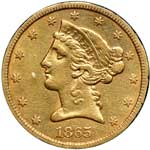 |
1865-S Sharpness of VF. Cleaned. Only 27,612 struck.
Estimated Value $500 - 550.
View details and enlarged photos
| Realized
$1,380 |
Lot 1749 |
 |
1874-S. SEGS graded VF-30. Lightly toned. Only 16,000 minted. Probably cleaned long ago.
Estimated Value $700 - 750.
View details and enlarged photos
| Unsold |
Lot 1750 |
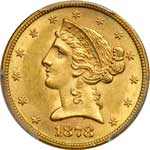 |
1878. PCGS graded MS-62. CAC Approved PQ. Well struck with nice gold toning. A frosty coin. Pop 37; 42 finer (PCGS # 8345) .
Estimated Value $650 - 700.
View details and enlarged photos
Check results on similar lots
| Realized
$891 |
Lot 1751 |
 |
1881. NGC graded MS-65. Well struck and fully lustrous, untoned. The surfaces on this handsome gem are judged by us to be vivid bright gold in color, and quite lustrous, with the grade acting on behalf of its outstanding quality. All this is perhaps obvious from the photos. What we need to emphasize also, from first-hand inspection with a magnifying glass, is that the strike is customarily crisp and detailed for the 1881 issue with its usual sharp metal flows into the deepest recesses of the dies on both sides. Pop 59; 13 finer (PCGS # 8354) .
Estimated Value $3,000 - 3,300.
View details and enlarged photos
Check results on similar lots
| Realized
$2,818 |
Lot 1752 |
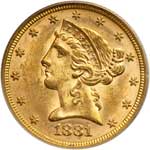 |
1881. PCGS graded MS-63 (PCGS # 8354) .
Estimated Value $550 - 600.
View details and enlarged photos
Check results on similar lots
| Realized
$690 |
Lot 1753 |
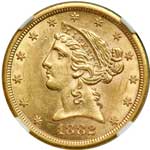 |
1882-CC. NGC graded MS-61. Only 82,817 minted of which merely 525 examples are estimated to have survived. Well struck and frosty. A splendid specimen of the 1882-CC, a Carson City half eagle that, when seen, is more often than not below the Mint State level, often several steps below. The present piece has outstanding eye-appeal and color here, with no unusual marks. It is quite choice in fact, particularly in the context of Carson City coinage, where most extant gold coins of smaller denominations show extensive surface abrasion. The present piece is a pure "find" for the advanced collector.
Only a single die pair has been observed for the 1882-CC. On the obverse a die scratch is seen through IB (LIBERTY), interrupted, then from the top of R down to the right through TY. On the reverse, on high-grade specimens as this, there are some die finish striae within the vertical shield stripes. On some later strikes, not seen here, the dies lightly clashed, and minor evidence of this shows near the eagle. Pop 16; 6 finer, 5 in 62, 1 in 63 (PCGS # 8359) .
Estimated Value $9,000 - 10,000.
View details and enlarged photos
Check results on similar lots
| Realized
$8,165 |
Lot 1754 |
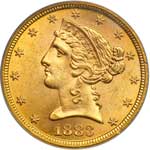 |
1883-S. PCGS graded MS-63. Some obverse marks on the cheek and elsewhere; choice frosty luster throughout. An attractive early S-mint date yet almost as affordable as the far commoner 1901-S (PCGS # 8363) .
Estimated Value $1,600 - 1,700.
View details and enlarged photos
Check results on similar lots
| Unsold |
Lot 1755 |
 |
1884. PCGS graded MS-63. Scarce in this grade, and a frosty, well struck Liberty five for the date collector. Mintage: 191,030 pieces (PCGS # 8364) .
Estimated Value $1,400 - 1,500.
View details and enlarged photos
Check results on similar lots
| Unsold |
Lot 1756 |
|
1885 and 1905-S. ANACS graded AU-50 and XF-45 respectively. Lot of 2 coins.
Estimated Value $700 - 750.
View details
| Realized
$863 |
Lot 1757 |
|
1886-S and 1903-S. Coins grade ANACS VF30 and PCGS XF45 respectively. Lot of 2 coins (PCGS # 8408) .
Estimated Value $700 - 750.
View details
Check results on similar lots
| Realized
$834 |
Lot 1758 |
 |
1891. PCGS graded MS-63. CAC Approved PQ. Nicely toned. Scarcer date, only 61,360 minted. Pop 30; 14 finer in 64 (PCGS # 8377) .
Estimated Value $1,100 - 1,200.
View details and enlarged photos
Check results on similar lots
| Realized
$1,323 |
Lot 1759 |
 |
1894-O. PCGS graded AU-58. Well struck (PCGS # 8388) .
Estimated Value $475 - 500.
View details and enlarged photos
Check results on similar lots
| Realized
$702 |
Lot 1760 |
|
1901 and 1902-S. Coins grade VF to XF . Lot of 2 coins.
Estimated Value $700 - 750.
View details
| Realized
$891 |
Lot 1761 |
 |
1903-S. NGC graded MS-62. Frosty and untoned (PCGS # 8408) .
Estimated Value $475 - 500.
View details and enlarged photos
Check results on similar lots
| Realized
$576 |
Lot 1762 |
 |
1905-S. PCGS graded MS-62. Lovely golden toning. Pop 65; 57 finer (PCGS # 8412) .
Estimated Value $700 - 750.
View details and enlarged photos
Check results on similar lots
| Realized
$719 |
Lot 1763 |
|
1881, 1882, and 1882-S. Coins grade XF to AU. Lot of 3 coins.
Estimated Value $950 - 1,000.
View details
| Realized
$1,495 |
Lot 1764 |
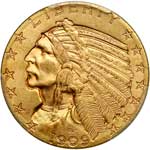 |
1909. PCGS graded MS-63. Light even toning over the lustrous surface. Pratt's $5 Indian Heads are struck using "recessed relief" -- a first on an American coin. The Indian $5 continued from 1908 to 1916, then a large gap before the final release of coins dated 1929 at the beginning of America's Great Depression called a halt to most gold coinage other than double eagles (PCGS # 8513) .
Estimated Value $1,200 - 1,250.
View details and enlarged photos
Check results on similar lots
| Realized
$1,380 |
Lot 1765 |
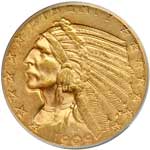 |
1909-D. PCGS graded MS-63. Housed in an Old Green Holder. Nicely toned (PCGS # 8514) .
Estimated Value $1,200 - 1,250.
View details and enlarged photos
Check results on similar lots
| Unsold |
Lot 1766 |
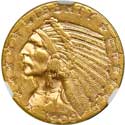 |
1909-D. NGC graded MS-61. Mostly untoned (PCGS # 8514) .
Estimated Value $525 - 550.
View details and enlarged photos
Check results on similar lots
| Realized
$633 |
Lot 1767 |
|
1911 and 1914. NGC graded AU-55 both. Lot of 2 coins.
Estimated Value $800 - 850.
View details
| Realized
$978 |
Lot 1768 |
|
1911 and 1912 Both XF40. Lot of 2 coins.
Estimated Value $800 - 850.
View details
| Realized
$891 |
Lot 1769 |
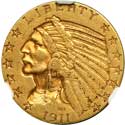 |
1911-S. NGC graded AU-53 (PCGS # 8522) .
Estimated Value $450 - 500.
View details and enlarged photos
Check results on similar lots
| Realized
$506 |
Lot 1770 |
|
1928 $2.5 and 1909-D $5 PCGS graded both Genuine Unc Details. Cleaning. Lot of 2 coins.
Estimated Value $550 - 600.
View details
| Realized
$805 |
|
|